Georgia is home to diverse fauna, and among its most awe-inspiring inhabitants are the birds of prey. These majestic creatures, also known as raptors, captivate with their impressive hunting skills, striking plumage, and commanding presence.
From the iconic bald eagle to the agile peregrine falcon, Georgia’s skies are alive with these formidable hunters.
In this introduction, we will explore some of the magnificent birds of prey found in the state, their unique characteristics, and their vital role in maintaining Georgia’s delicate ecosystem.
Join us on this journey as we uncover the fascinating world of birds of prey in Georgia.
24 Birds of Prey In Georgia
Georgia is a state with rich biodiversity and a variety of habitats, from mountains to coastlines. Among its many wildlife species, 24 birds of prey can be found in different state regions.
These raptors are fascinating animals that play an essential role in the ecosystem, as they help control the populations of rodents, insects, and other prey.
Here are 24 Birds of Prey In Georgia.
1. Red-Tailed Hawk
The red-tailed hawk is a type of bird known as a bird of prey. It is found in many different parts of North America. It breeds in various locations, from the interior of Alaska and northern Canada to Panama and the West Indies.
This means you can find red-tailed hawks in many places throughout North America. The red-tailed hawk belongs to a group of birds called the genus Buteo. This genus includes many other species of hawks.
However, the red-tailed hawk is one of the most common members of this group, both in North America and worldwide.
You will likely encounter a red-tailed hawk more often than others within the Buteo genus. The red-tailed hawk is known for its distinctive red tail, which is where it gets its name from.
This feature helps to distinguish it from other types of hawks. However, it is essential to note that not all red-tailed hawks have red tails.
Juvenile red-tailed hawks have brown tails, which only turn red as they mature. Red-tailed hawks are known for their impressive hunting skills. As birds of prey, they primarily.
| Kingdom | Animalia |
| Phylum | Chordata |
| Clade | Dinosauria |
| Class | Aves |
| Order | Accipitriformes |
| Family | Accipitridae |
| Genus | Buteo |
| Species | B. jamaicensis |
2. Peregrine Falcon
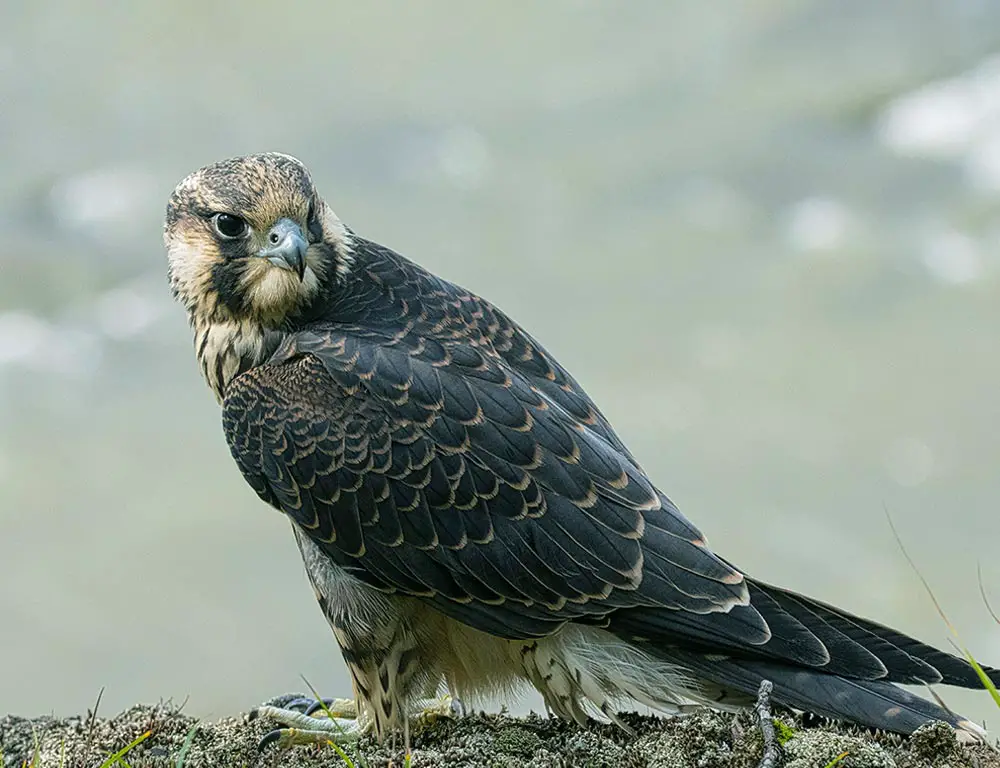
The peregrine falcon is a type of bird of prey that is found all around the world. It is sometimes called the peregrine or the duck hawk in North America. The peregrine falcon belongs to the Falconidae family. One characteristic of the peregrine falcon is its size.
It is quite large, similar to the size of a crow. This falcon has a blue-grey color on its back, with white underparts marked with bars. Its head is black. The peregrine falcon is particularly famous for its speed.
It is known to be one of the fastest birds in the world. This falcon can fly at incredibly high speeds while hunting for its prey. Its swift flying ability is truly remarkable. Being a bird of prey, the peregrine falcon hunts and feeds on other animals.
It primarily preys on birds, catching them mid-air during flight. This falcon has sharp talons that help it catch and hold onto its prey.
Its hunting technique is both impressive and efficient. The peregrine falcon is a cosmopolitan bird, meaning it can be found in various parts of the world. It.
| Kingdom | Animalia |
| Phylum | Chordata |
| Class | Aves |
| Order | Falconiformes |
| Family | Falconidae |
| Genus | Falco |
| Species | F. peregrinus |
3. American Kestrel
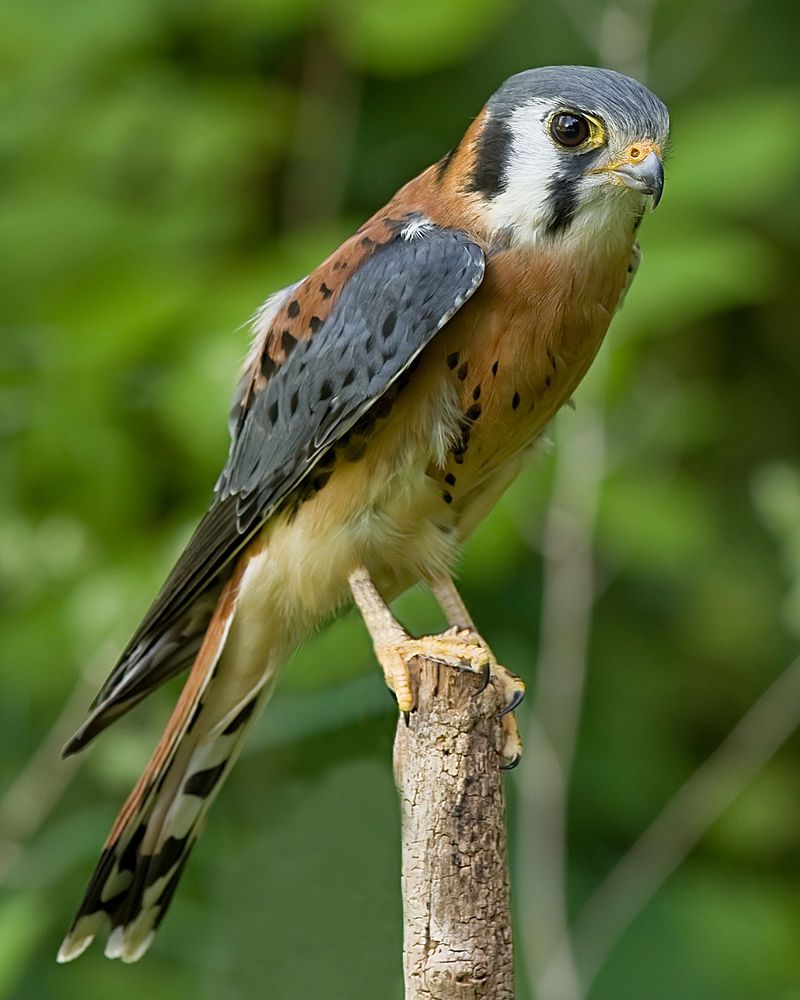
The American kestrel is a type of falcon that can also be known as the sparrow hawk. It is found in North America and is the region’s smallest and most common falcon. The size of the American kestrel can vary depending on the subspecies and the sex of the bird.
Generally, there is a two-to-one range in size between different individuals. When it comes to size, the American kestrel can range from being as small as a blue jay to as large as a mourning dove.
This means some individuals can weigh as much as a blue jay, while others can be as heavy as a mourning dove. The variation in size within the American kestrel population can be attributed to differences in subspecies and between males and females.
This means that females may generally be larger than males, and different subspecies may have different average sizes. Interestingly, despite this size variation, the American kestrel remains the smallest falcon in North America.
This indicates that even the largest individuals of this species are still relatively small compared to other falcons found in the region. In conclusion, the American kestrel is also known as the sparrow.
| Kingdom | Animalia |
| Phylum | Chordata |
| Class | Aves |
| Order | Falconiformes |
| Family | Falconidae |
| Genus | Falco |
| Species | F. sparverius |
4. Cooper’s Hawk
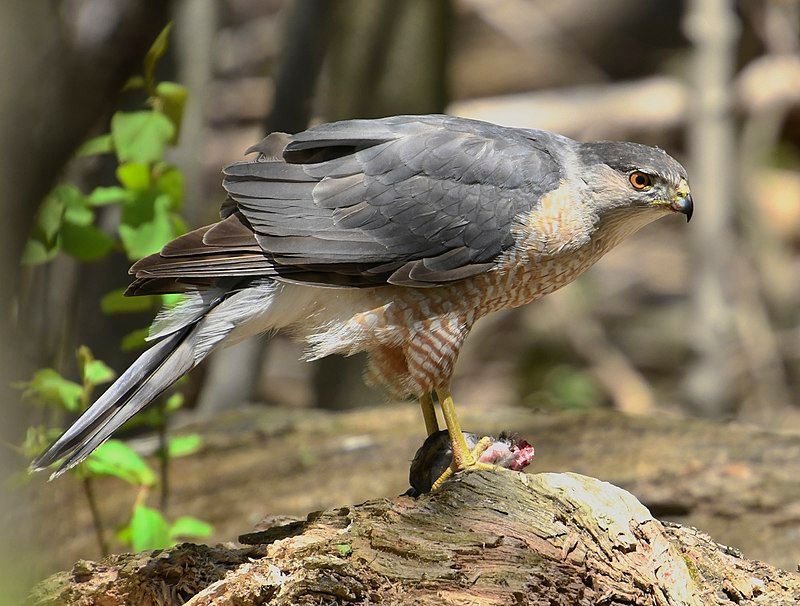
The Cooper’s hawk is a type of hawk found in North America. It is considered to be a medium-sized bird.
This species is native to the continent and commonly found in various regions ranging from southern Canada to Mexico. One interesting characteristic of the Cooper’s hawk is its size.
It falls into the category of medium-sized hawks, which means it is neither too big nor too small. This size allows the hawk to adapt and survive in different habitats across North America. The distribution of the Cooper’s hawk is quite extensive.
It can be found in North America, including southern Canada, the United States, and Mexico.
This wide range of habitats gives the hawk ample opportunities to thrive and establish its presence in various ecosystems. Despite its widespread distribution, the Cooper’s hawk is not evenly distributed throughout its range.
It tends to be more common in certain areas and less abundant in others. This variation in population density might be influenced by factors such as the availability of prey, nesting sites, and overall habitat suitability. The Cooper’s hawk is known for its hunting skills.
It primarily feeds on small to medium-sized birds, which it catches by surprise with speed and agility. This hawk is well-adapted.
| Kingdom | Animalia |
| Phylum | Chordata |
| Class | Aves |
| Order | Accipitriformes |
| Family | Accipitridae |
| Genus | Accipiter |
| Species | A. cooperii |
5. Sharp-Shinned Hawk
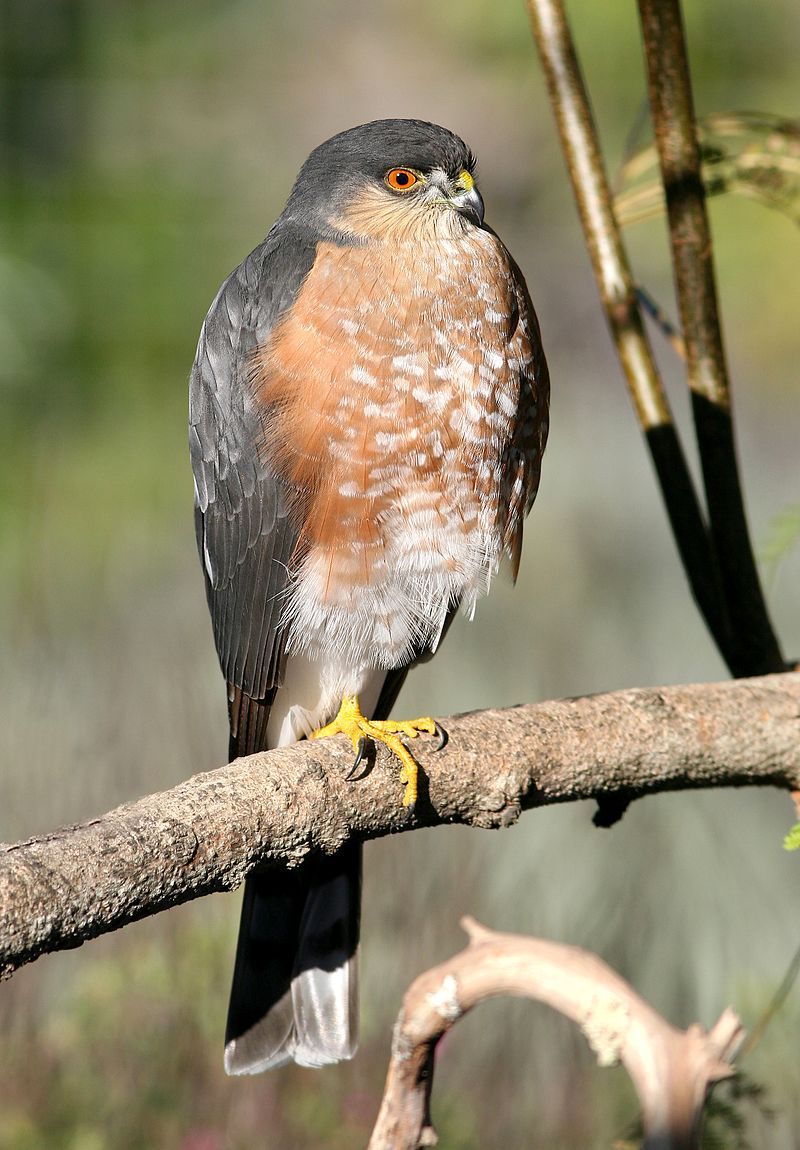
The sharp-shinned hawk, also known as a sharpie, is a small hawk type. The males of this species are the smallest hawks found in both the United States and Canada.
However, it’s worth noting that the sharp-shinned hawk is still larger than certain Neotropical species, such as the tiny hawk. This particular species of hawk is commonly referred to as a sharpie due to its sharp features and small size.
Although it is small compared to other hawks, it is important to understand that it is still larger than certain types of hawks found in the Neotropics, a region of the Americas encompassing Central and South America.
The sharp-shinned hawk’s size is noteworthy because it is the smallest hawk species found in both the United States and Canada.
This means that the sharp-shinned hawk stands out for its diminutive size compared to other hawks that inhabit these regions.
Furthermore, it is interesting to consider that despite being small in North American hawks, the sharp-shinned hawk is still larger on average than some Neotropical species, such as the tiny hawk.
This suggests that while the sharp-shinned hawk may be small relative to.
| Kingdom | Animalia |
| Phylum | Chordata |
| Class | Aves |
| Order | Accipitriformes |
| Family | Accipitridae |
| Genus | Accipiter |
| Species | A. striatus |
6. Red-Shouldered Hawk
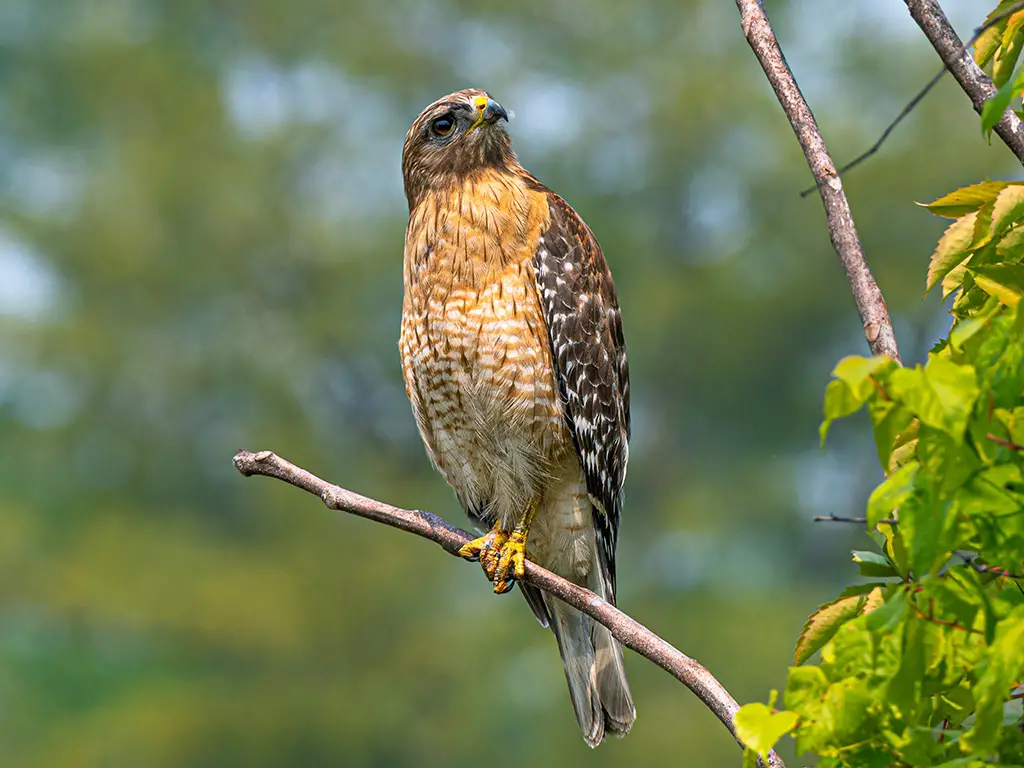
The red-shouldered hawk is a type of bird known as a medium-sized buteo. It can be found in various parts of North America, specifically in the eastern region, along the California coast, and in northern to northeastern-central Mexico.
This bird species is not migratory, as it is a permanent resident in most of its range. It chooses to stay in these areas year-round. However, there are some red-shouldered hawks in the northern parts of its range that do migrate.
They typically travel to central Mexico during their migration. The red-shouldered hawk is often seen in forests and woodlands, where it builds its nests and hunts for food. It prefers these habitats due to prey availability and suitable nesting sites.
These hawks have adapted to these environments and have become well-suited to their surroundings. As a medium-sized buteo, the red-shouldered hawk has certain characteristics that distinguish it from other birds.
Its size is not too large nor too small, making it a medium-sized bird. This allows it to have a good balance between agility and strength, which aids in its hunting and survival. One notable feature of the red-shouldered hawk is its red.
| Kingdom | Animalia |
| Phylum | Chordata |
| Class | Aves |
| Order | Accipitriformes |
| Family | Accipitridae |
| Genus | Buteo |
| Species | B. lineatus |
7. Osprey
The osprey is a bird known by different names such as sea hawk, river hawk, and fish hawk. It is a bird of prey that hunts and eats fish and is active during the daytime, which means it is diurnal.
The osprey can be found in various parts of the world, as it has a cosmopolitan range. In terms of size, the osprey is considered to be a large bird. It can grow to be more than 60 cm long, and its wingspan can reach 180 cm.
This makes it impressive when it takes flight and soars through the sky. In terms of appearance, the osprey has distinct coloring. The upper parts of its body are brown, which helps it blend in with its surroundings when perched on trees or other structures.
However, its head and underparts are predominantly greyish. This coloring may provide camouflage when the osprey is near bodies of water, where it hunts for fish. Overall, the osprey is a fascinating bird with unique characteristics.
Its ability to hunt fish, its large size, and its distinct coloring make it a remarkable species to observe in its natural habitat.
| Kingdom | Animalia |
| Phylum | Chordata |
| Class | Aves |
| Order | Accipitriformes |
| Family | Pandionidae |
| Genus | Pandion |
| Species | P. haliaetus |
8. Broad-Winged Hawk
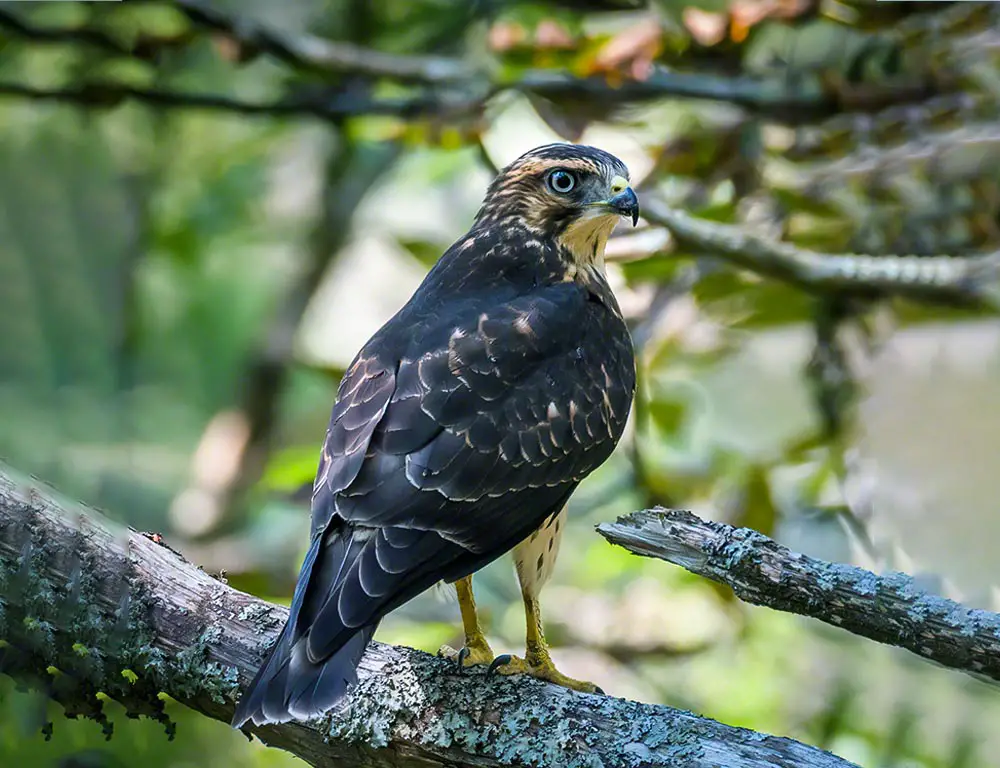
The broad-winged hawk is a type of hawk that is medium in size. It belongs to the genus Buteo. Some subspecies of this hawk are found in eastern North America during the summer. These subspecies can be found as far west as British Columbia and Texas.
However, when the winter season arrives, these hawks migrate to the Neotropics. The Neotropics is a region that extends from Mexico to southern Brazil. The broad-winged hawk can be seen in various parts of eastern North America during the summer.
This includes areas as far west as British Columbia and Texas. These hawks prefer to reside in this region during the warmer months. They build their nests and raise their young in these areas.
However, when the temperature drops and the winter season approaches, the broad-winged hawks begin their migration. They leave their summer homes in eastern North America and travel towards the Neotropics.
The Neotropics provide a more suitable environment for them during the colder months. The migration of these hawks takes them on a long journey. They fly southwards from their breeding grounds, crossing vast distances.
They travel through different regions, adapting to changing landscapes and weather conditions.
| Kingdom | Animalia |
| Phylum | Chordata |
| Class | Aves |
| Order | Accipitriformes |
| Family | Accipitridae |
| Genus | Buteo |
| Species | B. platypterus |
9. Golden Eagle

The golden eagle is a majestic bird found in the Northern Hemisphere. It is known for its impressive hunting skills and powerful presence in the sky.
The most widely distributed eagle species can be seen across various regions worldwide. Belonging to the family Accipitridae, the golden eagle shares its lineage with other eagles and birds of prey.
This family includes diverse species that share common characteristics and hunting techniques. One of the reasons why the golden eagle is so well-known is its status as a formidable bird of prey in the Northern Hemisphere.
Its impressive size, sharp beak, and powerful talons make it a fearsome predator.
It can take down prey larger than itself, demonstrating its remarkable strength and agility. The golden eagle’s habitat spans a wide range of landscapes, including mountains, forests, and open grasslands.
They are highly adaptable and thrive in various environments, from arid deserts to snowy mountain peaks.
Their adaptability contributes to their wide distribution and ability to survive in different climates. These birds have a striking appearance, with their golden-brown feathers and impressive wingspan.
| Kingdom | Animalia |
| Phylum | Chordata |
| Class | Aves |
| Order | Accipitriformes |
| Family | Accipitridae |
| Genus | Aquila |
| Species | A. chrysaetos |
10. Bald Eagle
The bald eagle is a type of bird that lives in North America. It is considered a bird of prey, which means it hunts and feeds on other animals. This majestic bird is also known as a sea eagle. There are two known subspecies of the bald eagle.
Subspecies are variations of a species that have slightly different characteristics but can still interbreed. These subspecies of the bald eagle might have some differences in appearance or behavior. The bald eagle is closely related to another bird called the white-tailed eagle.
These two birds form a species pair, which means they are similar and occupy similar ecological niches.
The white-tailed eagle is found in the Palearctic region, which includes Europe, Asia, and Africa. Occupying the same niche means that the bald and white-tailed eagles have similar roles in their respective ecosystems.
They both have adaptations that help them survive and thrive in their environments.
They might compete for similar food sources or have similar hunting strategies. In the Palearctic region, where the white-tailed eagle is found, it fulfills an ecological role similar to that of the bald eagle in North America.
This means both species have evolved to fill their habitats’ specific niche or role.
| Kingdom | Animalia |
| Phylum | Chordata |
| Class | Aves |
| Order | Accipitriformes |
| Family | Accipitridae |
| Genus | Haliaeetus |
| Species | H. leucocephalus |
11. Owl
Owls are a type of bird belonging to the order Strigiformes. This order includes more than 200 species of birds. Most owls are solitary, meaning they prefer to live alone.
They are also nocturnal, which means they are active during the night. One characteristic of owls is their upright stance. Unlike other birds that often perch horizontally, owls tend to stand vertically.
This upright posture helps them have a better view of their surroundings. Owls have a large and broad head. This feature allows them to have a big brain and excellent eyesight. Their eyes are positioned in the front of their face, which gives them binocular vision.
This means they can see things with depth perception, similar to humans. In addition to their eyesight, owls also have binaural hearing.
This means they can hear sounds from both ears independently. Their ears are located on the sides of their head and are asymmetrical.
This allows them to locate the source of sounds accurately. Owls are known for their sharp nails, which are their claws. These talons are used for catching and grasping their prey. Owls have a strong grip, allowing them to hold onto their prey tightly.
| Kingdom | Animalia |
| Phylum | Chordata |
| Class | Aves |
| Clade | Telluraves |
| Order | Strigiformes |
12. Eastern Screech Owl
The eastern screech owl, also known as the eastern screech-owl, is a small owl. It is commonly found in Eastern North America, from Mexico to Canada. This owl species is known for its small size, making it relatively easy to identify.
It is not particularly large like some other owl species. The eastern screech owl is considered a fairly common sight in its range, which covers a wide geographic area. Despite its name, the eastern screech owl does not only screech.
It has a variety of vocalizations, including whistles and trills. These sounds can be quite distinct and are often heard during the night.
This owl species is known for being vocal and can produce various calls. The eastern screech owl is primarily nocturnal, meaning it is most active at night.
It spends its days roosting in tree cavities or other hidden areas, using its excellent camouflage to blend in with its surroundings.
This owl’s plumage, or feathers, helps it remain well hidden and protected from predators during the daylight hours. This owl species has adapted well to living in various habitats, including forests, woodlands, and even.
| Kingdom | Animalia |
| Phylum | Chordata |
| Class | Aves |
| Order | Strigiformes |
| Family | Strigidae |
| Genus | Megascops |
| Species | M. asio |
13. Great-horned Owl
The great horned owl is a species of owl found in the Americas. It is also known by other names, such as the tiger owl and the hoot owl.
This owl is known for its adaptability and can be found in various habitats across its wide range. Being a large owl, the great horned owl has a distinct appearance. It has prominent ear tufts on its head, which give it a horned appearance.
This characteristic distinguishes it from other owl species. One of the remarkable traits of the great horned owl is its adaptability. It can be found in many habitats, including forests, deserts, mountains, and urban areas.
This versatility allows the owl to thrive in diverse environments, making it the most widely distributed true owl in the Americas. The great horned owl is a skilled hunter, preying on various animals. Its diet includes small mammals like rabbits, mice, and rats.
Additionally, it feeds on birds, reptiles, amphibians, and even other owls. This owl species has excellent hunting abilities. It possesses sharp talons and a powerful beak, which it uses to catch and kill its prey.
Its wings are designed for silent flight, allowing it to approach.
| Kingdom | Animalia |
| Phylum | Chordata |
| Class | Aves |
| Order | Strigiformes |
| Family | Strigidae |
| Genus | Bubo |
| Species | B. virginianus |
14. Northern Harrier
The northern harrier is a bird of prey commonly found in the northern parts of the northern hemisphere. Other names, such as the marsh hawk or ring-tailed hawk, also know it.
This bird is known for its exceptional hunting skills and distinctive appearance. Breeding is a significant part of the northern harrier’s life cycle. It prefers to breed in the northern regions of Canada and the northernmost parts of the United States.
These areas provide suitable habitats for the bird’s nesting and breeding activities. The northern harrier’s habitat mainly consists of marshes, wetlands, and open fields.
These environments offer an abundance of prey, including small mammals and birds, which the harrier hunts for food.
Its hunting technique is unique as it relies on low, slow flight and uses its keen sense of hearing and sight to locate and capture its prey. One remarkable characteristic of the northern harrier is its distinctive appearance.
It has long, narrow wings allow it to maneuver swiftly through the air. Its tail is also long and distinctive, resembling a ring.
This feature is why it is sometimes referred to as the ring-tailed hawk. The northern harrier is a medium-sized bird, with males usually being slightly smaller than females.
| Kingdom | Animalia |
| Phylum | Chordata |
| Class | Aves |
| Order | Accipitriformes |
| Family | Accipitridae |
| Genus | Circus |
| Species | C. hudsonius |
15. Merlin

The merlin is a type of falcon that can be found in various parts of the Northern Hemisphere. It is known for its small size compared to other falcon species.
The merlin has several subspecies in different regions of North America and Eurasia. These falcons are widely distributed across their habitat range and can be found in diverse environments. They can be seen in forests, grasslands, and even urban areas.
The ability of the merlin to adapt to various habitats contributes to its widespread presence. In North America, the merlin has different subspecies found in distinct regions.
For example, there is the prairie merlin, primarily found in the central grasslands of the continent. On the other hand, the taiga merlin inhabits the boreal forests of Canada and Alaska. In Eurasia, the merlin also has varied subspecies.
They can be found in countries like Russia, Norway, and Sweden, among others. Each subspecies may have specific adaptations and characteristics that suit their particular environment. The Merlin falcon is known for its agility and speed.
It is a skilled hunter capable of catching swift-flying prey such as small birds and insects.
| Kingdom | Animalia |
| Phylum | Chordata |
| Class | Aves |
| Order | Falconiformes |
| Family | Falconidae |
| Genus | Falco |
| Species | F. columbarius |
16. Rough-legged Buzzard
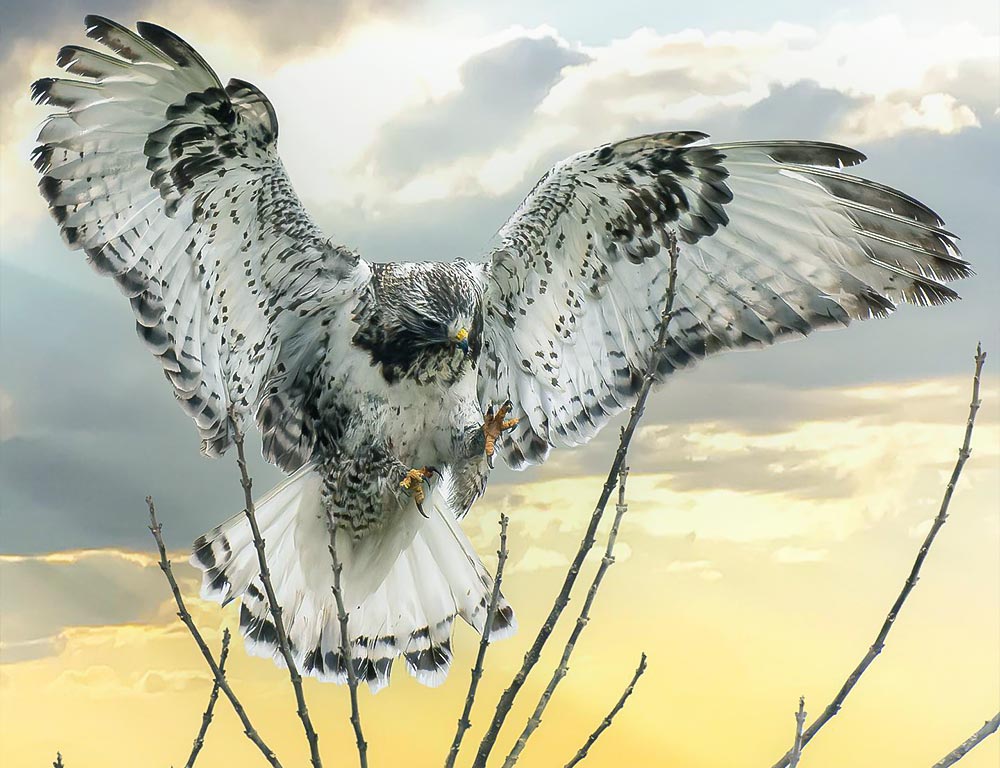
The rough-legged buzzard, also known as the rough-legged hawk, is a bird of prey that is medium-large in size.
It can be found in the Arctic and Subarctic regions of North America, Europe, and Russia. During the breeding season, these buzzards make their home in these regions.
However, when winter arrives, they migrate south. These birds are well-suited to survive in the harsh Arctic and Subarctic climates. They have adapted to the cold weather and snowy landscapes of these regions.
The rough-legged buzzard has several physical characteristics that help it thrive in these environments. One of the distinctive features of the rough-legged buzzard is its feathered legs.
These feathers extend down to its feet, providing insulation against the cold temperatures.
This adaptation allows the bird to maintain its body heat and prevents frostbite. The rough-legged buzzard also has a large wingspan, which helps it soar through the air effortlessly.
This enables the bird to cover long distances during migration and efficiently search for prey.
Their wings are broad and rounded, making them well-suited for gliding and hovering. When it comes to hunting, the rough-legged buzzard primarily feeds on small mammals, such as rodents. It has.
| Kingdom | Animalia |
| Phylum | Chordata |
| Class | Aves |
| Order | Accipitriformes |
| Family | Accipitridae |
| Genus | Buteo |
| Species | B. lagopus |
17. Swainson’s Hawk
Swainson’s hawk is a type of bird that belongs to the Accipitriformes order. This means that it is classified along with other hawks, eagles, and vultures.
It is a relatively large bird species, known for its impressive size and strength. The name “Swainson’s hawk” comes from William Swainson, a British naturalist who played a significant role in studying and documenting various species of birds.
He was particularly interested in birds of prey, and this hawk species was named after him to honor his contributions to the field of ornithology. In addition to its scientific name, Swainson’s hawk is also known by a couple of colloquial names – the grasshopper hawk and the locust hawk.
These names reflect the hawk’s feeding habits and preferences. The bird is especially fond of an insect called Acrididae, which includes grasshoppers and locusts. When given the opportunity, Swainson’s hawks will voraciously eat these insects.
This means that they will consume them eagerly and in large quantities. This behavior is likely because Acrididae insects are abundant in the hawk’s natural habitat, providing a readily.
| Kingdom | Animalia |
| Phylum | Chordata |
| Class | Aves |
| Order | Accipitriformes |
| Family | Accipitridae |
| Genus | Buteo |
| Species | B. swainsoni |
18. Barn owl
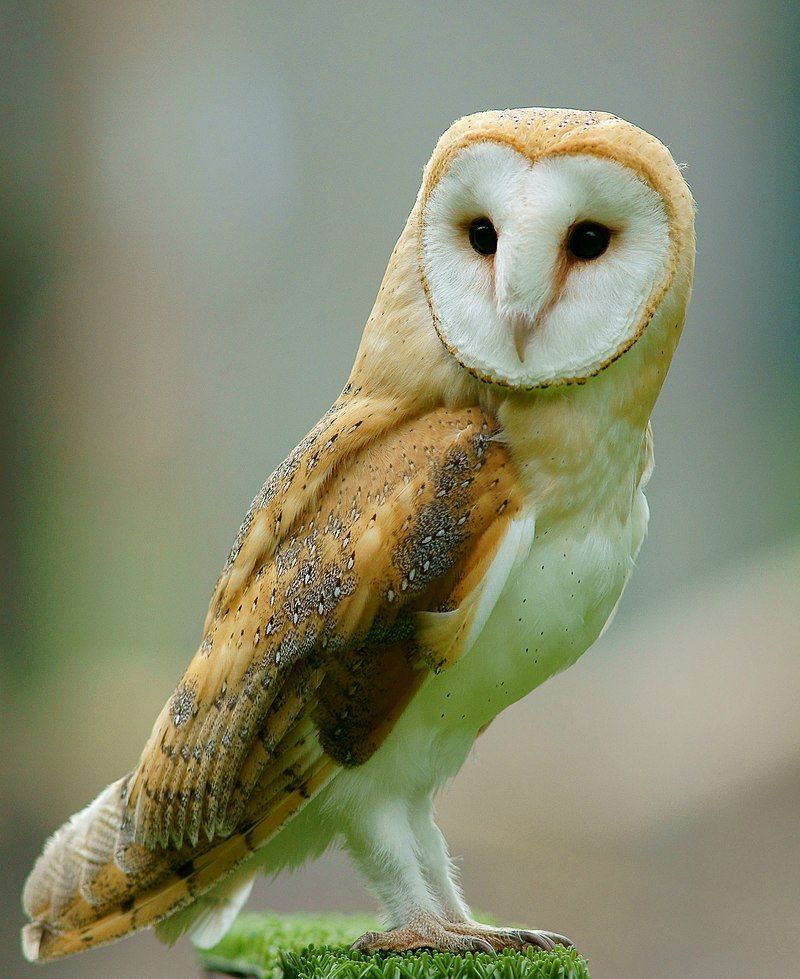
The barn owl is a type of owl that can be found in many different parts of the world. It is the most widely distributed species of owl globally. It is one of the most widespread species of birds overall.
Barn owls can be found in almost every region, with a few exceptions. They are not typically found in polar regions or desert areas. These types of environments do not provide the necessary resources and conditions for the barn owl to thrive.
Additionally, barn owls are not commonly seen in certain parts of Asia, specifically north of the Himalayas. This could be due to a variety of factors, such as the availability of suitable prey or nesting sites. Some islands in Indonesia are also not home to barn owls.
It is unclear why these particular islands do not have barn owls, but it could be due to geographical, ecological, or historical factors. Furthermore, there are specific Pacific Islands where barn owls are not present.
These islands may lack the resources or habitats for barn owls to survive and reproduce successfully. Overall, the barn owl has a wide distribution and can be found in many parts of the world. However.
| Kingdom | Animalia |
| Phylum | Chordata |
| Class | Aves |
| Order | Strigiformes |
| Family | Tytonidae |
| Genus | Tyto |
| Species | T. alba |
19. Barred Owl
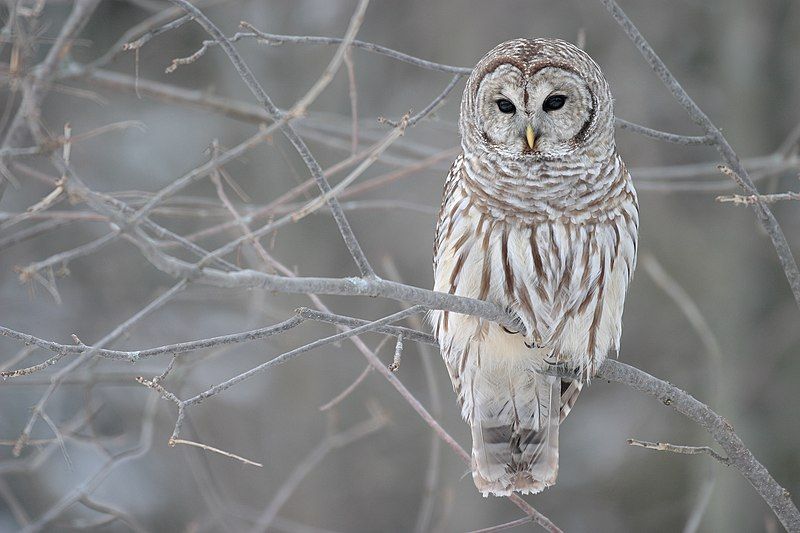
The barred owl is a type of owl found in North America. It is sometimes called the northern barred owl, striped owl, hoot owl, or eight-hooter owl.
This owl is quite large compared to other owls. It belongs to a family of owls called Strigidae, known as true owls. The barred owl specifically belongs to the genus Strix.
The name of the family, Strigidae, comes from the genus Strix. Linnaean taxonomy is a system of naming and classifying organisms created by Carl Linnaeus, a Swedish botanist.
This system organizes living organisms into different categories based on their characteristics. The barred owl’s scientific name is Strix varia.In Linnaean taxonomy, the genus name comes first, followed by the species name.
So for the barred owl, Strix is the genus and varia is the species.
This helps scientists and researchers identify and study different species. The barred owl is known for its distinctive call, which sounds like “who-cooks-for-you, who-cooks-for-you-all.” This call is often heard at night, which is why it is sometimes referred to as a hoot owl.
| Kingdom | Animalia |
| Phylum | Chordata |
| Class | Aves |
| Order | Strigiformes |
| Family | Strigidae |
| Genus | Strix |
| Species | S. varia |
20. Turkey Vulture

The turkey vulture is a type of vulture found in many different parts of the Americas. It is the most widespread of all the New World vultures. There are three species of vultures in a group called the genus Cathartes.
The turkey vulture is one of these species. It belongs to the family Cathartidae, a bird group that includes vultures. The turkey vulture can be found in a vast range of locations.
It can be seen from southern Canada down to the very tip of South America. This means it can be found in many different American countries and environments. This bird has an extensive range because it is well-adapted to various habitats.
It can thrive in a wide range of conditions and climates. The turkey vulture is known for its characteristic appearance. It has a bald head, which is red. Its body is black or dark brown, with long wings and a long tail.
This vulture is a scavenger, meaning it feeds on dead animals. It has a highly developed sense of smell, which allows it to locate carrion from high.
| Kingdom | Animalia |
| Phylum | Chordata |
| Class | Aves |
| Order | Accipitriformes |
| Family | Cathartidae |
| Genus | Cathartes |
| Species | C. aura |
21. Hawk

Hawks belong to the family Accipitridae and are known as birds of prey. These birds are found in various locations worldwide, except for Antarctica. They have a wide distribution and can be seen on all continents.
The subfamily Accipitrinae consists of different types of hawks, such as goshawks, sparrowhawks, and sharp-shinned hawks. These species share common characteristics and are closely related to each other.
Goshawks are a type of hawk that belongs to the subfamily Accipitrinae. They are known for their agile and powerful flying abilities. Goshawks have sharp talons and a strong beak that they use to catch and feed on their prey.
They are often found in forested areas, hunting small to medium-sized birds and mammals. Sparrowhawks, another member of the Accipitrinae subfamily, are smaller in size compared to goshawks. They are known for their exceptional agility and speed.
Sparrowhawks have specialized flight techniques that enable them to navigate through dense vegetation while hunting small birds, such as sparrows (hence their name). They have sharp talons and a hooked beak.
| Kingdom | Animalia |
| Phylum | Chordata |
| Clade | Dinosauria |
| Class | Aves |
| Order | Accipitriformes |
| Family | Accipitridae |
22. Harris’s Hawk
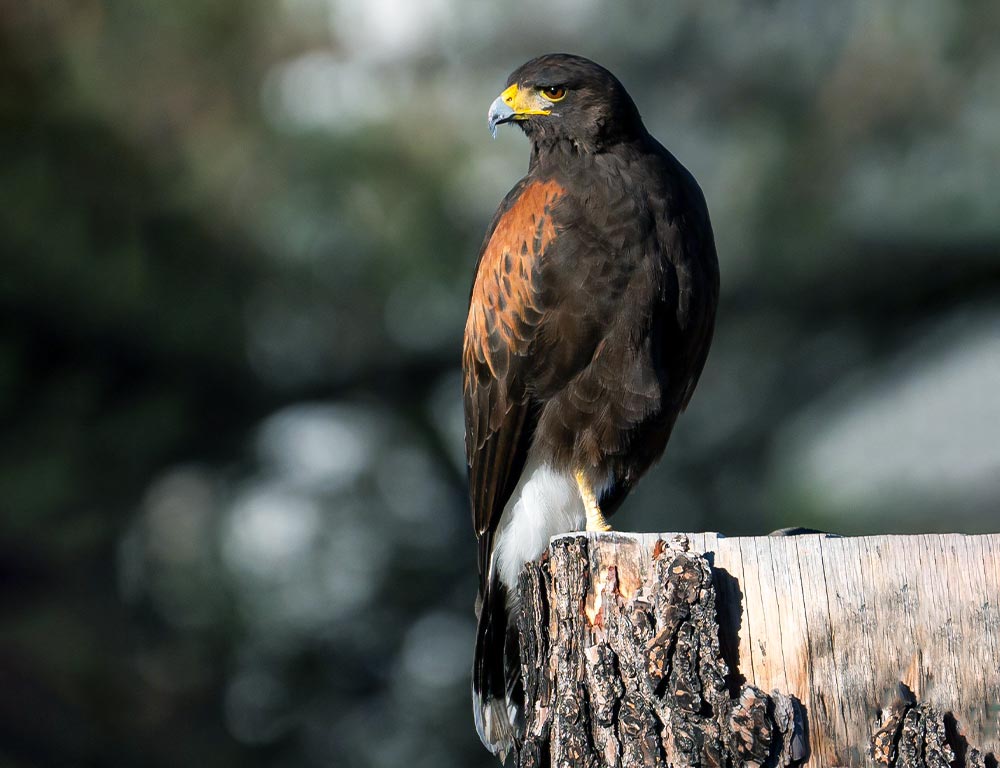
The Harris’s hawk is a bird of prey that used to be called the bay-winged hawk. It is also known as the dusky hawk and sometimes called a wolf hawk. In Latin America, it is called the peuco. This bird is medium to large and is found in various regions.
The Harris’s hawk is known to breed in the southwestern part of the United States and in countries like Chile, central Argentina, and Brazil. These birds have many habitats and are adaptable to different environments.
They can be found in desert areas, grasslands, and urban areas. Being a bird of prey, the Harris’s hawk is a skilled hunter. It has sharp talons and beaks to capture and kill its prey. These birds primarily feed on small mammals, birds, and reptiles.
They have keen eyesight, which helps them spot their prey from a distance and make accurate dives to catch it. One interesting behavior of the Harris’s hawk is its ability to hunt cooperatively.
They often work together in groups to capture larger prey that would be difficult for a single bird to handle. This cooperative hunting strategy is unique among raptors.
| Kingdom | Animalia |
| Phylum | Chordata |
| Class | Aves |
| Order | Accipitriformes |
| Family | Accipitridae |
| Genus | Parabuteo |
| Species | P. unicinctus |
23. Black Vulture
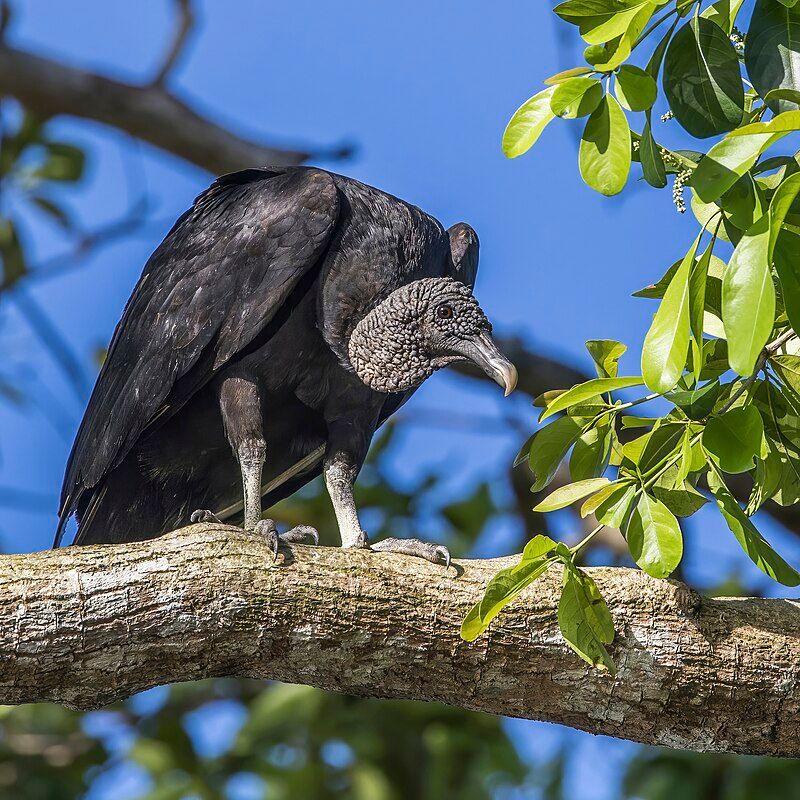
The black vulture is a type of bird belonging to the New World family. Other names, such as the American black vulture, Mexican vulture, zopilote, urubu, or gallinazo, also know it.
This bird is found in different regions, from the southeastern United States to Perú, Central Chile, and Uruguay in South America. The black vulture has a wide range of distribution, which means it can be found in many different areas.
It is commonly seen in the southeastern parts of the United States, where it is native. However, it is also found in various countries in South America, including Perú, Chile, and Uruguay.
This indicates that the black vulture has adapted to different environments and can thrive in diverse habitats. One interesting fact about the black vulture is its feeding habits. It is a scavenger which primarily feeds on carrion or dead animals.
This bird can uniquely locate carcasses using its excellent sense of smell. It can detect the scent of decaying flesh from miles away, making it an efficient scavenger. The black vulture has distinct physical characteristics that make it easily recognizable.
| Kingdom | Animalia |
| Phylum | Chordata |
| Class | Aves |
| Order | Accipitriformes |
| Family | Cathartidae |
| Genus | Coragyps |
| Species | C. atratus |
24. Mississippi Kite
The Mississippi kite is a type of bird that belongs to the Accipitridae family. It is a small bird of prey, which means it hunts for food. This bird has narrow and pointed wings, which help it soar through the air gracefully.
When flying, it often looks like it is floating effortlessly in the sky. Multiple Mississippi kites are expected to be circling in the same area. These birds are known for their impressive flight abilities.
Their narrow wings allow them to maneuver swiftly and change direction quickly. This makes them skilled hunters who can swiftly swoop down on their prey without much effort.
Their graceful flight patterns make them a captivating sight to behold. One interesting behavior of the Mississippi kite is its tendency to circle in the air. This behavior is often observed when several kites are in the same area.
They fly in circles, following a pattern, and it almost seems they are dancing in the sky.
This circling behavior could serve multiple purposes, such as searching for food, establishing territory, or even courtship displays. The Mississippi kite is mainly found in North and South America, particularly in the southern parts of the United States. These birds prefer.
| Kingdom | Animalia |
| Phylum | Chordata |
| Class | Aves |
| Order | Accipitriformes |
| Family | Accipitridae |
| Genus | Ictinia |
| Species | I. mississippiensis |
Conclusion
Birds of prey play a vital role in Georgia’s ecosystem. These majestic creatures, including hawks, eagles, and owls, soar through the skies and hunt for food, maintaining a balance within the environment by controlling rodent and small mammal populations.
With their keen eyesight, sharp talons, and powerful beaks, these birds demonstrate extraordinary hunting skills. The diverse habitats of Georgia provide ample resources and nesting sites for birds of prey, contributing to the state’s rich biodiversity.
However, these magnificent creatures face various threats, including habitat loss, pollution, and illegal hunting.
Conservation efforts, such as protected areas, captive breeding programs, and public education, are essential to ensure the survival and well-being of Georgia’s birds of prey.
By safeguarding these remarkable birds, we preserve their natural heritage and maintain a healthy ecosystem for the overall benefit of Georgia’s wildlife and human population.